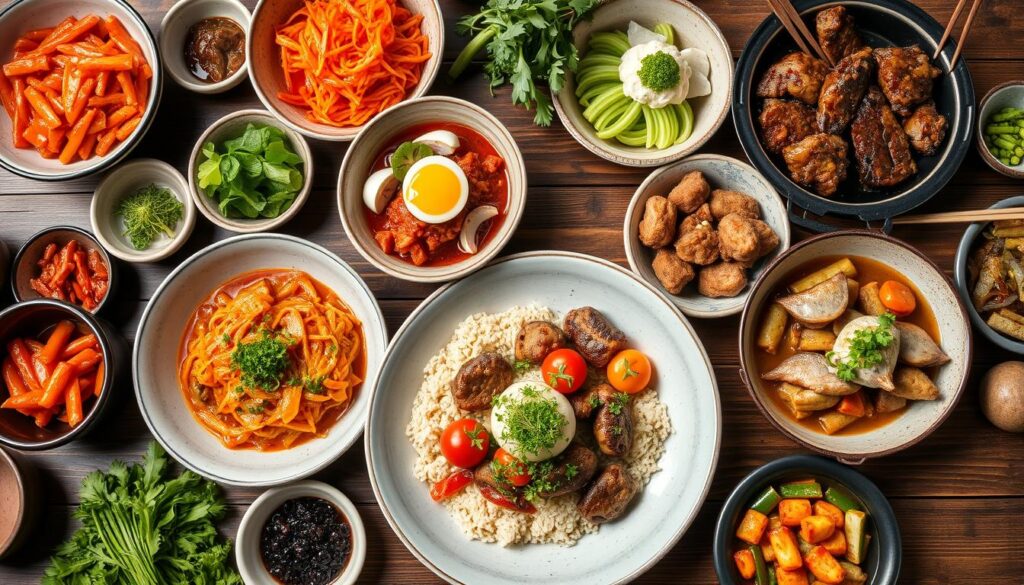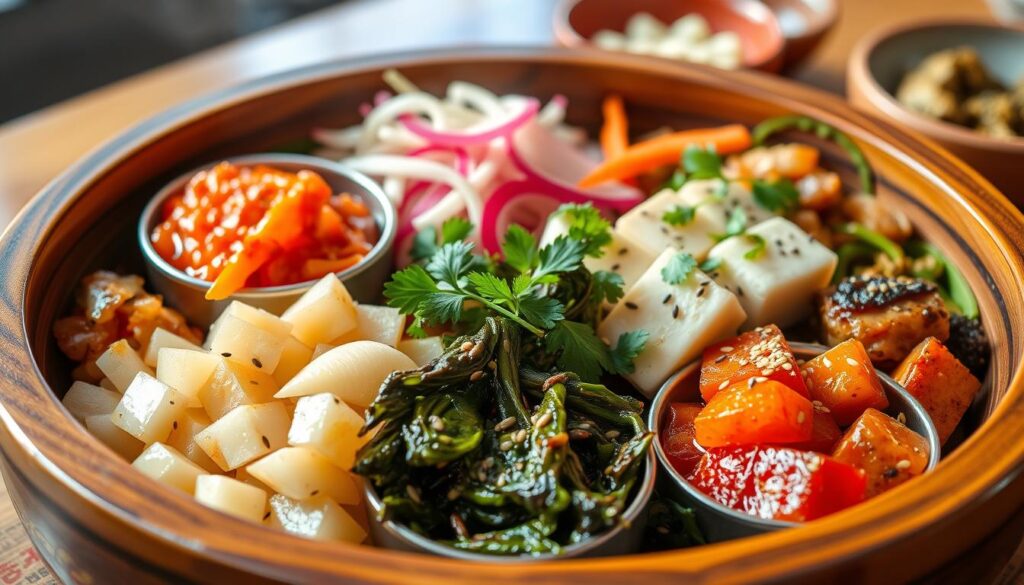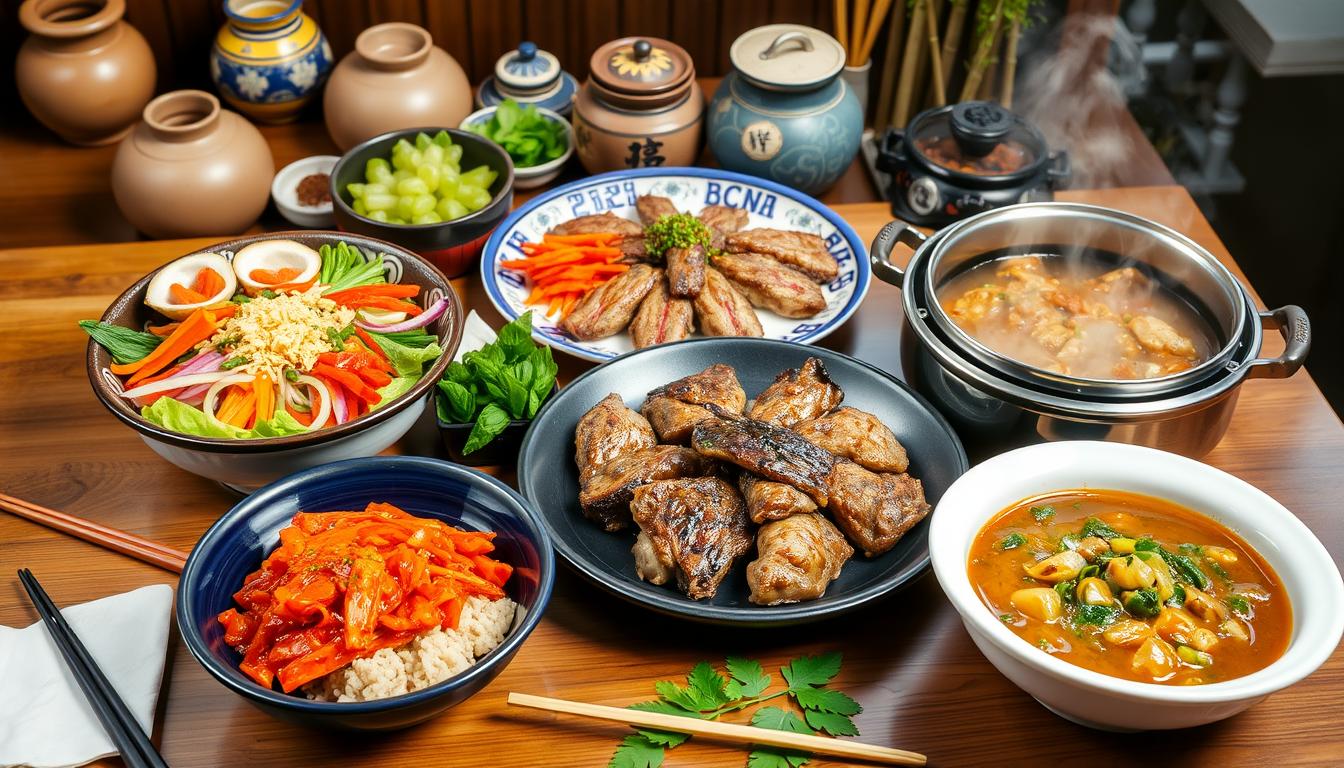As I stepped into my kitchen, the smell of Korean spices and sesame oil filled the air. It reminded me of Seoul’s lively streets. My family loved Korean food, bringing us comfort and joy. Now, I’m excited to share these flavors with you.
In this guide, you’ll find easy Korean recipes that truly capture the essence of Korean cuisine. You’ll try everything from spicy kimchi stew to modern fusion dishes. This journey will excite your senses and satisfy your cravings for bold flavors.
Table of Contents
Spicy Kimchi Stew: A Traditional Soulful Delight
Spicy kimchi stew, also known as kimchichigae, is a favorite Korean dish. It highlights the bold, complex tastes of fermented kimchi. The stew’s rich flavor comes from aged kimchi, adding a sour, spicy kick.
This recipe helps you unlock the unique tastes of kimchi. It shows you how to make an authentic Korean classic that will warm your heart. The stew’s comforting broth and tender ingredients make it a must-try for Korean cuisine lovers.
Harnessing the Flavors of Fermented Kimchi
The secret to a great kimchi stew is the quality of the fermented kimchi. Choose kimchi that’s aged well. This allows the flavors to blend and intensify.
The aged kimchi brings a strong, sour, and spicy taste to the stew. This creates a perfect balance of Korean flavors.
Preparing an Authentic Korean Classic
To make a real kimchi stew, start by simmering the kimchi in a flavorful broth. Let the ingredients mix well. You can add pork, seafood, or tofu to the stew for different tastes.
When serving, pour the kimchi stew hot. Top it with Korean flavors like green onions, sesame seeds, and a bit of sesame oil. This dish will warm your heart and take you to the heart of Korean cuisine.
« Kimchi stew is a true reflection of the depth and complexity of Korean cooking. It’s a dish that nourishes the body and delights the senses. »
Korean Beef: A Quick and Flavorful Weeknight Meal
Discover the bold and authentic flavors of Korean cuisine with this easy-to-prepare Korean beef dish. It uses ground beef instead of traditional flank steak. This makes it more accessible and affordable to enjoy Korean barbecue at home.
The marinade is the secret to this dish’s success. It infuses the beef with a mix of soy sauce, brown sugar, and aromatic seasonings. In just 15 minutes, you can have a satisfying Korean-inspired meal perfect for busy weeknights.
Serve the Korean beef over steaming white rice or fresh lettuce wraps. Let the flavors take you on a culinary journey to Seoul. This versatile recipe is sure to become a new family favorite.
| Prep Time | Cook Time | Total Time | Servings |
|---|---|---|---|
| 5 minutes | 10 minutes | 15 minutes | 4 |
Ingredients:
- 1 pound ground korean beef
- 1 onion, diced
- 3 garlic cloves, minced
- 3 tablespoons soy sauce
- 2 tablespoons brown sugar
- 1 teaspoon ground ginger
- 1 teaspoon toasted sesame oil
- 1/2 teaspoon red pepper flakes (optional)
- Chopped green onions, for garnish
- Toasted sesame seeds, for garnish
This korean beef recipe is a quick and easy weeknight meal. It brings the bold flavors of korean cuisine to your table. With simple asian inspired recipes like this, you can enjoy a delicious quick and easy meal without sacrificing time or taste.
« This Korean beef dish is a game-changer for my weeknight dinner routine. The flavors are absolutely fantastic, and it comes together in a flash. Highly recommend! »
Exploring the Essence of Korean Cooking
To truly understand Korean cuisine, we must explore its key ingredients and flavors. The rich, fermented sauces and pastes add depth. Sweet, spicy, and savory notes balance in many dishes. These elements are crucial for experiencing authentic Korean flavors.
Essential Ingredients for Authentic Flavors
Korean cuisine relies on a few key ingredients. Gochujang, a fermented red chili paste, adds a spicy-sweet flavor. Doenjang, a soybean paste, brings a deep, savory taste. Soy sauce, sesame oil, garlic, ginger, and green onions also play important roles.
Balancing Sweet, Spicy, and Savory Notes
Korean cooking is known for its sweet, spicy, and savory balance. Ingredients like brown sugar, gochujang, and fermented sauces help achieve this. This balance creates a harmonious taste experience that invites you to try more.
« Korean cuisine emphasizes farm-fresh, locally sourced produce to capture the taste of harmony. »
korean recpies: Unlocking the Secrets of Korean Cuisine
Start a fun journey through the exciting world of Korean cuisine. This guide to Korean recipes will show you the secrets of this tasty tradition. You’ll learn about classic dishes and modern twists, exploring the wide range of Korean dishes.
If you love the spicy kick of kimchi, the rich flavors of Korean barbecue, or the colorful banchan side dishes, this section is for you. You’ll get the skills to make these favorite Korean dishes at home.
Explore the rich world of Korean cooking and discover the unique Korean flavors. Learn about seasoning, balance, and fermentation. You’ll see what makes Korean cuisine so special and delicious. Get ready to be inspired and make authentic Korean dishes at home.

Get ready for a culinary adventure with Korean recipes. Let this guide be your key to the vibrant and tasty world of Korean food.
Classic Korean Barbecue: Grilling Traditions
Korean barbecue, or gogigui, is a beloved tradition in Korea. It’s all about bold, smoky flavors and sharing meals together. This grilling method has been around since the Goguryeo era (37 B.C.–668 A.D.). Today, Korean barbecue is a key part of Korean food, loved for its tasty marinades and the joy of eating with family and friends.
Mastering the Art of Korean Marinades
The heart of Korean barbecue is the marinade. These flavors are what make Korean cuisine special. Whether it’s bulgogi (thinly sliced, marinated beef) or galbi (beef short ribs), the marinade turns simple ingredients into amazing dishes.
- Key ingredients in Korean marinades include soy sauce, brown sugar, garlic, ginger, and gochujang, a spicy Korean chili paste.
- The mix of sweet, savory, and spicy is key. It creates a flavor that boosts the meat’s natural taste.
- Marinating for a few hours to overnight is important. It lets the flavors soak deep into the meat or veggies, making Korean barbecue dishes irresistible.
Learning to make Korean marinades is the first step to making authentic Korean grilling at home. By using these traditional methods, you can bring the flavors of Seoul right to your table, one delicious bite at a time.
« The essence of Korean barbecue lies in the perfect balance of flavors, where the marinade seamlessly unites the smoky char of the grill with the natural sweetness of the meat. »
Banchan: The Vibrant Side Dish Culture
Korean cuisine is famous for its diverse and tasty side dishes, called banchan. These small plates are key to every Korean meal. They add balance with their textures, tastes, and looks. Learning to make authentic korean banchan and korean vegetable recipes reveals the beauty of korean cuisine and its unique korean flavors.
Preparing Flavorful Vegetable Accompaniments
At the core of korean side dishes are vibrant vegetable creations. From crunchy pickled radishes to rich sautéed greens, these korean banchan dishes highlight traditional Korean ingredients. Whether you’re making a quick side for dinner or enhancing your korean cuisine experience, learning korean vegetable recipes is a fulfilling journey.
- Kongnamul Muchim: A classic Korean banchan made with soybean sprouts, this dish comes together in just 15 minutes, making it a convenient option for busy days.
- Sigeumchi Namul: This seasoned spinach side dish is not only delicious but also packed with nutrients like iron, vitamins, and fiber.
- Oi Muchim: A zesty and refreshing spicy cucumber salad, Oi Muchim is an ideal accompaniment for Korean meals or barbecue spreads.
- Hobak Bokkeum: This stir-fried zucchini dish is known for its simplicity and speed, perfect for quick weeknight preparation.
- Gaji Namul: Steamed eggplant is the star of this banchan, which can be whipped up in minutes and stores well for future meals.
Making these flavorful korean side dishes needs focus on detail. It’s about choosing quality vegetables and finding the right mix of sweet, savory, spicy, and tangy flavors. By using traditional Korean cooking methods, you can bring the lively spirit of korean cuisine to your home.

« Banchan are the heart and soul of Korean cuisine, offering a symphony of flavors and textures to complement every meal. »
Hearty Korean Stews and Soups
Korean cuisine is famous for its comforting stews and soups. These dishes, like the spicy kimchi stew and the rich beef bone soup, warm both body and spirit.
The kimchi stew (kimchi-jjigae: 김치찌개) is a beloved Korean dish. It has over 6.2 million views on YouTube and a 4.8-star rating from 613 votes. It’s a mix of fermented kimchi, pork, and aromatic seasonings.
The Budae Jjigae, or « Korean Army Stew, » is another iconic dish. It started after the Korean War, mixing canned meats from U.S. bases with Korean ingredients. Featured on « Parts Unknown, » it’s now a global Korean cuisine favorite.
| Dish | Key Ingredients | Calories per Serving |
|---|---|---|
| Kimchi Stew | Kimchi, pork, tofu, green onions | NA |
| Budae Jjigae | Spam, sausage, kimchi, ramen noodles, tofu | 855 |
Looking for something spicy like kimchi stew or savory like Budae Jjigae? These Korean stews and soups offer a comforting journey through Korean cuisine.
« Budae Jjigae, also known as Korean Army Stew, has evolved from a simple wartime meal into an internationally recognized Korean cuisine classic. »
Korean Street Food Favorites
Korean street food, or « pojangmacha, » is a vibrant and beloved part of Korea’s culinary culture. It offers a wide range of tasty and easy-to-eat snacks and small bites. From cheesy and spicy fire chicken to crispy Korean corn dogs, you can make these delicious flavors at home.
Recreating Beloved Snacks at Home
Tteokbokki is a favorite, with rice cakes in a sweet and spicy sauce. It’s loved by all ages. Hotteok, a dessert with griddle cakes and sweet fillings, is perfect for cold weather.
Sundae, a savory dish with animal parts, is a unique treat. Deep-fried Squid, or Ojingeo Twigim, is a tasty fried snack for squid lovers.
| Korean Street Food Dish | Description | Popularity |
|---|---|---|
| Tteokbokki | Rice cakes soaked in a sweet and spicy sauce | A traditional crowd-pleaser across all age groups |
| Hotteok | Griddle cakes filled with sweet ingredients like sugar and fruits | A popular dessert dish, especially in colder weather |
| Sundae | A unique twist on the blood sausage concept, combining various animal parts | A flavorful and filling savory snack |
| Ojingeo Twigim | Deep-fried squid | A satisfying deep-fried snack for squid enthusiasts |
Looking for something sweet, savory, or both? Korean street food has a wide range of korean snacks you can make at home. It brings the lively flavors of korean cuisine right to your kitchen.
« The video recipe for Korean Street Toast has been watched 1,316,918 times on YouTube, and it’s rated 5/5 from 551 votes. This recipe is a true crowd-pleaser! »
Fusion Korean Cuisine: Modern Twists
Korean cuisine is changing fast, thanks to chefs who mix old traditions with new flavors. This mix has created exciting Korean-inspired dishes loved worldwide. From Korean-Mexican tacos to Korean pasta, the options are endless.
At the core of this change is a deep respect for Korean cooking. Chefs use key Korean ingredients like soy sauce and gochujang in international dishes. This blend brings together the best of both worlds, offering unique tastes.
Korean Fried Chicken is a great example of this fusion. It combines traditional Korean tastes with modern cooking. The result is a dish that’s both crispy and juicy, loved by many.
The fusion movement in Korean cuisine is growing fast. Chefs and food lovers are finding new ways to mix Korean flavors with global dishes. This creates a new culinary world that’s both familiar and exciting. Whether you love Korean food or are new to it, there’s always something new to try.
| Fusion Dish | Korean Influence | International Elements |
|---|---|---|
| Korean-Mexican Tacos | Bulgogi (marinated beef), Kimchi | Corn tortillas, Avocado, Lime |
| Korean-Inspired Pasta | Gochujang (Korean chili paste), Soy Sauce | Pasta, Parmesan Cheese, Garlic |
| Korean Fried Chicken | Soy Sauce, Ginger, Garlic | Fried Chicken Technique |
Exploring fusion Korean cuisine is a journey into a world of flavors. It celebrates Korean heritage while embracing global creativity. Discover the beauty of korean fusion cuisine, modern korean recipes, korean inspired dishes, and korean flavors that will delight your senses.
Vegetarian and Vegan Korean Dishes
Korean food is all about fresh veggies, fermented foods, and deep flavors. It’s perfect for those who follow a vegetarian or vegan diet. This section shows you tasty Korean dishes made without meat or animal products.
Plant-Based Adaptations of Classic Recipes
Discover dishes like tofu kimchi stews and vegetable banchan. They’re all about Korean flavors without meat. Dive into plant-based korean cuisine and enjoy meatless korean food that’s full of life.
| Dish | Description | Key Ingredients |
|---|---|---|
| Vegetarian Korean Bowls | A hearty and flavorful plant-based dish featuring a mix of vegetables, protein-rich ingredients, and a sweet and spicy Korean sauce. | Vegetarian ground beef or crumbles, shredded kale, Brussels sprouts, carrots, broccoli, snow peas, soy sauce, brown sugar, sesame oil, garlic, ginger. |
| Vegan Kimchi Jjigae | A comforting and authentic-tasting Korean stew made with aged kimchi, shiitake mushrooms, potatoes, and a blend of essential Korean seasonings. | Aged kimchi, shiitake mushrooms, potatoes, gochugaru, gochujang, dashima, tofu, black beans. |
Explore the world of vegetarian korean recipes and vegan korean dishes. Enjoy the rich tastes of Korean food without giving up your diet.
Conclusion
In this guide, you’ve explored the vibrant world of korean cuisine. You’ve learned to make many delicious korean recipes at home. From classic dishes to modern twists, you now know how to bring these bold flavors into your kitchen.
Whether you love korean food or are just starting, this article has you covered. It gives you the confidence to make Korean dishes in your own kitchen. The growing interest in korean cuisine in places like Abu Dhabi shows its appeal.
Korean recipes are not just tasty; they’re also good for you. With lots of veggies, fermented foods, and balanced flavors, they offer great nutrition. Dive into the traditions and flavors of korean cooking and enjoy a healthy, flavorful journey.

